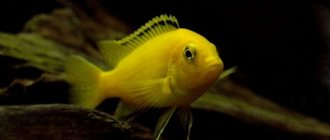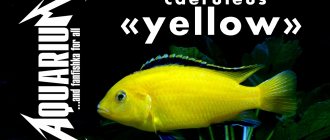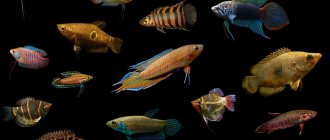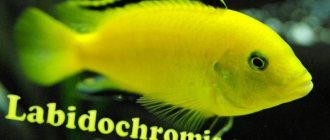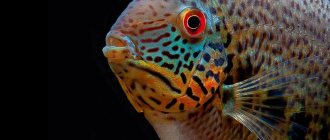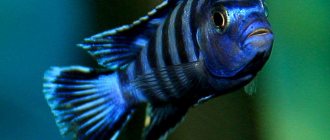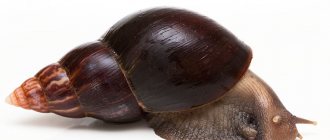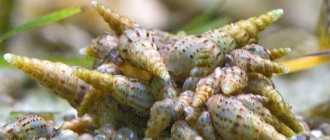Labidochromis yellow, or labidochromis caeruleus var. Yellow, is the most popular labidochromis fish.
Its bright color is one of 13 possible variations. Belongs to the cichlid family, the mbuna group, and is distinguished by its peaceful disposition for cichlids.
Caring for the fish is quite simple, which makes it suitable for keeping in a home aquarium for both beginners and experienced aquarists.
Kinds
Labidochromis is endemic to Lake Malawi in Africa. The most popular aquarium Malawian cichlids include 8 varieties .
Labidochromis yellow
The fish got its name from its lemon-yellow color. On the dorsal fin there is a black stripe that runs through the entire plumage.
This cichlid is considered small, but its body size can reach up to 10 cm.
Hongi
Quite a rare fish, but its popularity among aquarists is gradually growing due to the unusual color of the cichlid.
Males are blue or light blue in color, but in the frontal part, on the back of the head and on the dorsal fin, the color can range from yellow to bright orange.
Interesting! Juveniles and females are much paler, most often brown with pale orange dorsal plumage.
An adult fish can grow a little more than 13 cm, juveniles about 9 cm.
Kimpuma ed.
These rather large cichlids are artificially bred morphs of Hongi. Their distinctive feature is the color of the head, occipital and dorsal parts, which can range from reddish-orange to bright red.
Males in an aquarium grow up to 11–12 cm, and females - up to 10.
Interesting! Using this species as an example, it was found that during the absence of the male, the older female can change color to a color characteristic of the stronger sex.
Moreover, over time, she changes her sexual role, taking part in spawning as a male, while losing the ability to lay eggs.
Mbamba Bay
Mbamba Bay has a beautiful blue body color with dark blue transverse stripes. The plumage is black with yellow edging. The fish is medium in size, usually no more than 10 cm.
Chizumulu
It is considered a dwarf cichlid, since the size rarely exceeds 9 cm, and females can be up to 7 cm.
The females of this species have a modest cream or beige coloration, while the males are distinguished by a soft blue hue with dark transverse stripes reaching the middle of the body.
Nkata Bay
Labidochromis nkata bay, however, like many other cichlids, was named after the place where it was first caught.
The fish has a beautiful white color with a pearlescent tint, the plumage is transparent blue with a black stripe - the mark is missing only on the caudal fin.
Textile
The color of this fish is unique and looks more like a patterned blanket than a natural creation.
The blue color of the body is speckled with brown specks, which form longitudinal stripes running from head to tail.
The size of the cichlid is modest - only 7 cm.
Blue
Males are brighter colored than females, their blue bodies are lined with blue or purple transverse stripes. Can grow up to 12 cm.
What to feed?
Yellow labidochromis should not be given tubifex and bloodworms. Fish react to such food with serious digestive upset and may die.
From live food, they can be given coretra and brine shrimp.
You also need to purchase dry food suitable for Labidochromis from a pet store.
Food for fish
The diet should consist of 50% plant foods. The fish are given spirulina or purchased special herbal feed additives at the pet store. In summer, give finely chopped dandelion leaves and lettuce.
These fish should not be overfed, otherwise bloating may occur, which often leads to death. Feed once a day. The dosage is selected by observing the fish; it is necessary that they immediately eat all the food offered to them within a few minutes.
Once a week they have a fasting day, that is, they don’t feed them at all.
Labidochromis are unpretentious when it comes to food - they eat both live (small bloodworms, coretra) and dry balanced food (preferably special for cichlids). Adult fish can be given small pieces of squid, shrimp, lean meat, and fish. A third of the Labidochromis diet should consist of plant foods. Spirulina-based granules are now available for sale, or you can give the fish scalded lettuce leaves, nettle leaves, as well as riccia and duckweed.
It is better to immediately purchase a school of fish, and among them there should be large specimens (most likely males) and smaller ones with rounded contours (females). Young labidochromis should not be a very bright yellow, but rather a yellowish-gray color. There should not yet be a black stripe on the dorsal fin, or very faint.
Description
Labidochromis cerulius was first described in 1956 and classified as an endemic species found in Lake Malawi.
Natural habitat
Cerulius prefer fresh, warm reservoirs with a rocky bottom . They like to hide in small caves and under snags.
Appearance
The characteristics of the fish are as follows:
- the body is elongated, slightly flattened laterally;
- the color is bright, rich, without bald spots, the plumage has a black edging (on the anal and ventral fins too);
- black eyes, very expressive;
- in an aquarium, cerulius grows up to 10 cm, while in a natural environment its size does not exceed 8 cm.
View this post on Instagram
Posted by Cichlid Kmv (@cihlida_malawi_kmv) Apr 11, 2021 at 9:20 am PDT
Lifespan
If you do not violate the recommendations for care and maintenance, then labidochromis can live up to 10 years.
Adviсe
- Buy quality yellow food. Take an interest in reviews of manufacturers and avoid buying feed in bulk. Always look at expiration dates.
- Before introducing a new fish, quarantine it for 3-4 weeks. If you do not observe signs of disease, the fish can be placed in a community aquarium.
- Place the aquarium only on a special stand; it is quite strong so as not to break under the weight of the water tank.
- For a more intense color, add food that enhances color to your Labidochromis diet. Properly selected lighting will also reveal the beauty of yellow.
Labidochromis is a whole genus of cichlids, currently numbering 18 species with different colors, sizes and features. Yellow is the most popular species among its fellows.
Previous
Fish4 popular species of otocinclus catfish
Next
Fish Why is the turquoise acara called the “green terrorist”?
Content
Among other cichlids, cerulius have the most peaceful character . The bright color and simple keeping conditions make it possible for labidochromis to be present in beginner aquariums.
Aquarium
It is better to choose a tank from 100 liters. It should contain grottoes, caves, stones, snags and vegetation - in general, all those elements that will serve as shelter for the fish.
Water parameters
The optimal temperature for cichlids is 25…27 °C. Water is required to be hard, from 1 to 25 units, with a bias towards alkaline with a pH of 7–8, rich in oxygen, for which a good purification filter and an aerator are installed.
Plants
Although in the environment familiar to Labidochromis there is no abundance of vegetation, flora is still needed for decoration and additional gas exchange .
It is best to place cryptocorynes and anubias in a reservoir with cichlids: ceruliuses do not eat them, and the bushes easily take root in almost any reservoir.
Priming
It is better to choose dark shades for the substrate; against such a background, labidochromis look even brighter.
The soil should contain:
- sand;
- stone or marble chips;
- crushed shells.
Equipment
Cichlids do not require bright light to live comfortably . These are bottom-dwelling fish, so the lighting for the aquarium should be dim, preferably with diffused light.
You will need a powerful water filtration system and a good compressor.
View this post on Instagram
Posted by Alexey Savinov (@pundikot) Oct 23, 2021 at 11:35 PDT
Feeding
In an artificial reservoir, fish are prone to overeating, so it is better to divide the daily food intake into two feedings: morning and evening .
Important! Labidochromis is a predator, like all cichlids; its mouth contains sharp, slightly curved teeth, which are designed to extract prey from crevices in rocks.
The fish diet can be constructed as follows:
- plant-based dry food;
- small mollusks, insects, larvae and crustaceans;
- seaweed;
- spirulina tablets;
- plants (lettuce, dandelion leaves).
Feeding Hummingbird Cichlids
These fish are considered predators, but in fact their diet consists mainly of plant foods, which means there will be no problems with nutrition. For feeding, you need to buy inexpensive cichlid food in stores , as well as frozen food. From time to time you can please your aquarium pets with bark. To diversify your diet, you can add finely chopped lettuce and spinach leaves.
The amount of feed should be limited. Overeating is harmful for yellow cichlids. Experts recommend giving only half the daily requirement at a time. If you do not follow this rule, the fish’s belly will swell and they will die.
It is very useful to give your pets dry food, which is based on plant materials. They contain a large amount of vitamins, minerals and keratin, which is responsible for the bright color of the scales.
Content compatibility
Cerullis are peaceful compared to other cichlids, but can be incredibly cruel to other fish. The best neighbors for them will be:
- other cichlids of comparable size;
- ancestrus;
- corridors;
- blue dolphins;
- cockroaches.
You should not put yellow in the same aquarium with labidochromis:
- angelfish;
- guppy;
- swordtails;
- zebrafish;
- barbs;
- goldfish;
- platy.
Reviews
Labidochromis yellow behaves differently: some successfully keep it with guppies and neons, while others show aggression towards their neighbors. Some aquarists keep yellowfish with American cichlids, but most agree that a tank with African species is the best and most aesthetically pleasing option.
Breeding
It is optimal to form small flocks, where there are 2–3 females per male . Males show aggression towards each other, which causes their plumage to suffer.
Male and female: how to distinguish
Sexual dimorphism in Labidochromis yellow is weakly expressed, and it can be difficult for beginners to make out who is who.
During the spawning period, males usually acquire brighter colors than females . Another difference is the shape of the forehead: in males it is more convex, and their ventral fins are black.
Spawning
Cerulis do not need to create special conditions for reproduction; they manage to produce offspring even in the presence of more aggressive neighbors. But to preserve the brood, it is better to remove the female from a common reservoir .
A separate aquarium of a relatively small volume is prepared, future parents are placed in it and fed well.
The male’s task is to prepare a place for safe spawning and attract the female there.
After spawning, the female sucks the eggs into her mouth and incubates it this way throughout the entire maturation period (24–39 days).
The fry are born completely independent.
Reproduction
Sexual differences in yellow labidochromis are extremely weakly expressed; a beginner will never be able to tell whether the specimen in front of him is male or female. They are the same size and color. During the spawning period, the color of the male may be a little brighter and brownish spots appear on the head. It usually has black, rather than yellow, fins on its abdomen, but this sign is not always obvious.
If the aquarium contains only labidochromis, then the pair does not need to be removed for breeding. A flock in which there is one male for every 4-5 females is excellent for spawning in the same place where it lives.
Sexual maturity occurs in this species of cichlids by 6-8 months.
The spawning tank must be at least 150 liters with stones and plants. It should be in a quiet place and not be heavily lit; it is better to create twilight.
The fish must be fed very well before spawning.
Females usually lay eggs on a rocky bottom, sometimes the male digs a hole. After the male fertilizes the clutch with milk (for about an hour), the female collects the eggs and carries them in her mouth.
During a kind of “pregnancy” - carrying the fry in her mouth - the mother becomes very weak, so this period stretches for 30 days, and she cannot feed. She can bear up to 40 cubs at a time, but only about 10 babies survive the first spawning; usually twice or three times as many survive the second. After the fry leave the mother's mouth, the parents take care of them for another 7-10 days.
At this time, it is necessary to introduce the first complementary food in the form of small plankton and live dust. Babies usually form a school and quickly move through the water in search of food. After a couple of months they grow to 1.5-2 cm long.
Diseases
Most health problems in labidochromis occur due to violation of the conditions of detention or incorrectly selected neighbors in the aquarium.
Injuries
Most fish injuries occur due to fights between males and collisions with decorative elements.
Therefore, it is important to maintain the ratio of males and females in the tank so that the gentlemen do not show excessive aggression.
When installing new decorative elements, it is important to make sure that they do not have sharp protrusions or corners that could harm the fish.
Poisoning
Heavy metal salts, chlorine and ammonia dissolved in water can cause deterioration in the health of fish and lead to poisoning. Signs of intoxication are:
- loss of coordination;
- rapid breathing;
- decreased activity.
To prevent poisoning, reserve water for replacement. thoroughly, but without detergents , or it is better to keep them in a separate container for 3-5 days before installing them in the aquarium.
Tuberculosis
Unfortunately, it is almost impossible to save a sick fish. It is placed in a separate aquarium and a solution of vitamin B6 is added to the water. The disease enters the aquarium along with infected fish.
Ichthyophthirosis, or semolina
This disease is characterized by white dots that appear abundantly on the body of the fish. Zelenka is used as a treatment.
Fin rot
The disease is characterized by the appearance of a whitish coating on the plumage of fish, and then red stains. The fins are completely destroyed over time.
Antibiotics, brilliant green and gentian violet solution are used as treatment.
Range and Habitat
Africa: Endemic to the central and western coastal region of Lake Malawi in East Africa. Found in the northern part of the lake, between Kaiser Point and Lando, and from Chirmbo Point to Charo. The "electric yellow" color morph has only been recorded on the western side of Nkhata Bay between Charo and Lion Bay.
It lives in the lake in two different biotopes, occurring in rocky areas and also in areas covered with Vallisneria aethiopica vegetation. They are found at the greatest depth of all species of the genus Labidochromis, found at depths of 10 to 30 meters, rarely found at depths less, usually they can be found at a depth of about 20 meters.
In the wild, they live either alone or in pairs and are a mouth-incubating species that forms a matriarchal family. Depending on their habitat, they feed primarily on lithophilous (rock-loving) invertebrates, mollusks and snails, and also feed on fish and insects.
One population was found in shallow water, where it lives mainly in thickets of Vallisneria and preys on snails.
Interesting Facts
Cerulius are very tenacious. They show amazing ingenuity in matters of safety and are able to survive in the same body of water even with larger predators.
Labidochromis willingly dig up the bottom in search of food . Sometimes they are able to move not too heavy decorative elements simply by pushing them.
If labidochromis fry are kept in a pond with plants, then there is a high probability that when they grow up, they will not eat the bushes.
Cerulius are very beautiful and unpretentious fish. They are easily adaptable and do not require special conditions , so even a novice aquarist can handle them.
